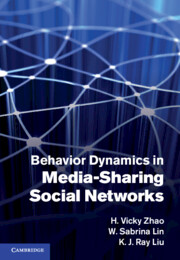Book contents
- Frontmatter
- Contents
- Preface
- Part I Introduction
- Part II Behavior forensics in media-sharing social networks
- 5 Equal-risk fairness in colluder social networks
- 6 Leveraging side information in colluder social networks
- 7 Risk–distortion analysis of multiuser collusion
- Part III Fairness and cooperation stimulation
- Part IV Misbehaving user identification
- Part V Media-sharing social network structures
- References
- Index
7 - Risk–distortion analysis of multiuser collusion
from Part II - Behavior forensics in media-sharing social networks
Published online by Cambridge University Press: 28 April 2011
- Frontmatter
- Contents
- Preface
- Part I Introduction
- Part II Behavior forensics in media-sharing social networks
- 5 Equal-risk fairness in colluder social networks
- 6 Leveraging side information in colluder social networks
- 7 Risk–distortion analysis of multiuser collusion
- Part III Fairness and cooperation stimulation
- Part IV Misbehaving user identification
- Part V Media-sharing social network structures
- References
- Index
Summary
In the previous chapter, we used multimedia fingerprinting social network as an example and examined the impact of side information on users' strategies. We showed that information about the statistical means of detection statistics is useful to improve the detection performance. A straightforward question to ask is whether there is other information that may potentially influence user dynamics. In this chapter, we investigate how side information changes the risk–distortion relationship in linear video collusion attacks against Gaussian fingerprints.
Video data have the unique characteristic that temporally adjacent frames are similar but usually not identical. Video collusion attacks include not only the intercopy attack that combines the same frames from different copies, but also the intracopy attack that combines temporally adjacent frames within the same copy. Because temporally adjacent frames are not exactly the same, an intracopy collusion attack will introduce distortion. Therefore, for a video collusion attack, there exists a tradeoff between the fingerprint remaining in the colluded copy that determines colluders' probability of being detected – that is, their risk – and the quality of the colluded copy – the distortion. It is extremely important for colluders to learn the risk–distortion tradeoff, as knowing this tradeoff would help them choose the best strategy when generating the colluded copy. It is also essential for the fingerprint detector to understand the risk–distortion tradeoff, as it would help predict colluders' behavior and design an anticollusion strategy.
- Type
- Chapter
- Information
- Behavior Dynamics in Media-Sharing Social Networks , pp. 111 - 128Publisher: Cambridge University PressPrint publication year: 2011



